Visiting Herculaneum, a Roman city destroyed by the same volcano that engulfed Pompeii, is really rewarding. Here’s how to visit Herculaneum, and why it should be as much of a priority on your trip to Italy as seeing Pompeii.
Over 3.5 million people visit the ancient Roman city of Pompeii every year. Buried by tonnes of volcanic ash and rocks when Mount Vesuvius erupted in AD79, it’s one of the best-known tourist sites in Italy.
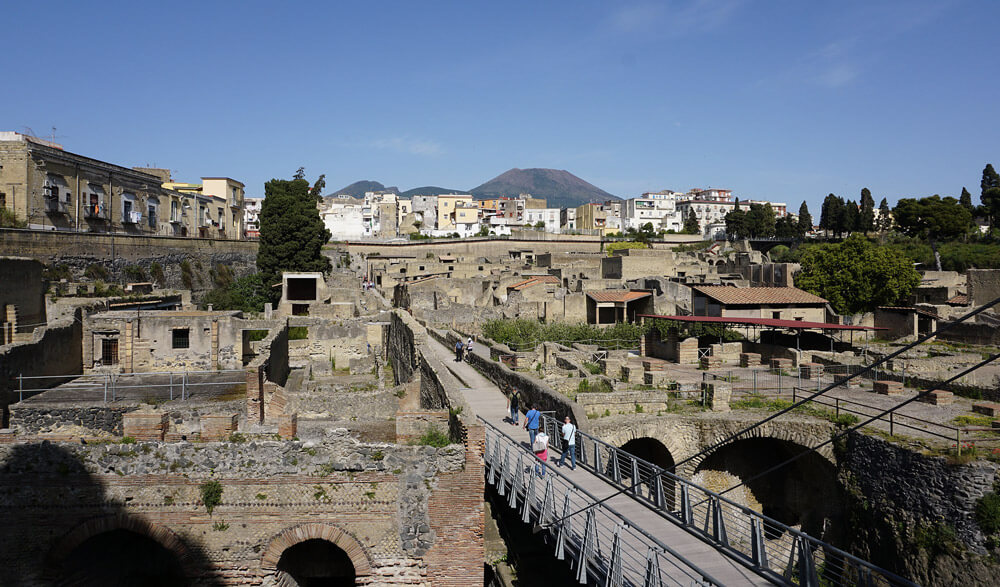
But there’s another Roman city just down the road from Pompeii that’s even better preserved and that receives only a tenth of the visitors that go to Pompeii. That city is Herculaneum, and it’s well worth a visit.
Where is Herculaneum?
Herculaneum, like Pompeii, was a Roman town on the coast of southern Italy, between modern-day Naples and Sorrento. You’ll find the ruins in the modern town of Ercolano. The ancient town actually extends underneath the modern one – what’s been excavated is probably only a small portion of what was covered when Vesuvius erupted.
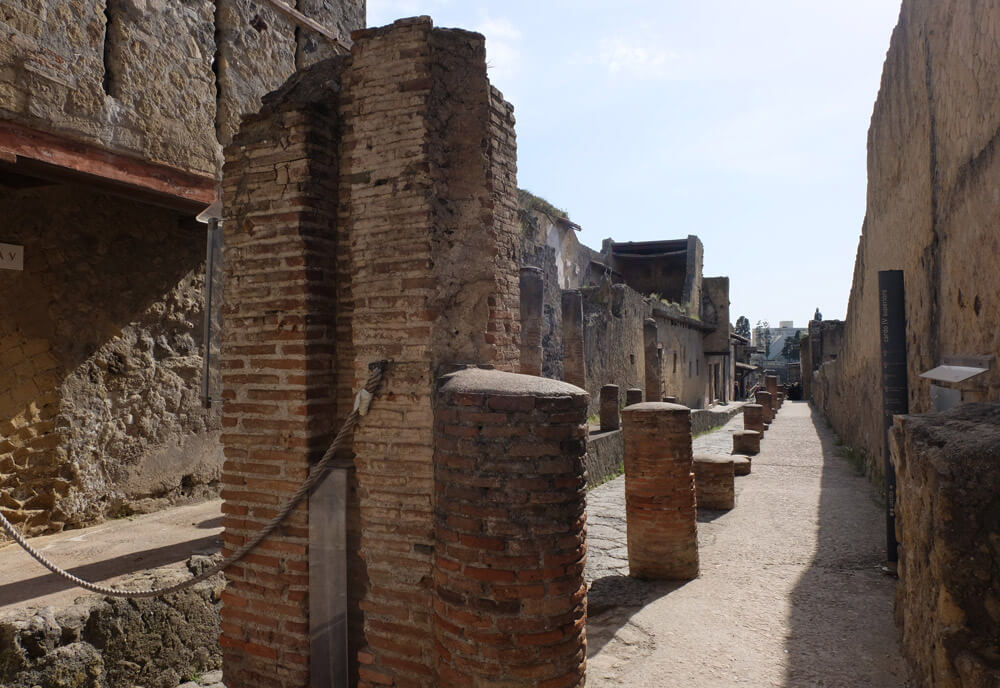
Herculaneum lies on the opposite side of Mount Vesuvius to Pompeii, and although they shared the same fate when the volcano erupted, they were destroyed in different ways; Pompeii by a 25-metre thick shower of falling rocks, Herculaneum by a lethal 100mph, 400°C pyroclastic surge of hot gas and ash.
Is it worth visiting Herculaneum?
I found Herculaneum just as fascinating as Pompeii. Here are some reasons why you should consider visiting Herculaneum.
Herculaneum is really different to Pompeii
The main reason to visit Herculaneum is because it’s so different to Pompeii. Don’t miss out on going to Herculaneum because you think it’s just a smaller version of Pompeii; it really isn’t.
Herculaneum is much better preserved than Pompeii
There’s a massive difference in the level of preservation at Herculaneum compared to Pompeii. When Mount Vesuvius erupted, the buildings in Pompeii were damaged by a deluge of falling rocks before being buried in lava and ash, meaning that very little survives above the ground floor, and virtually every building lost its roof.
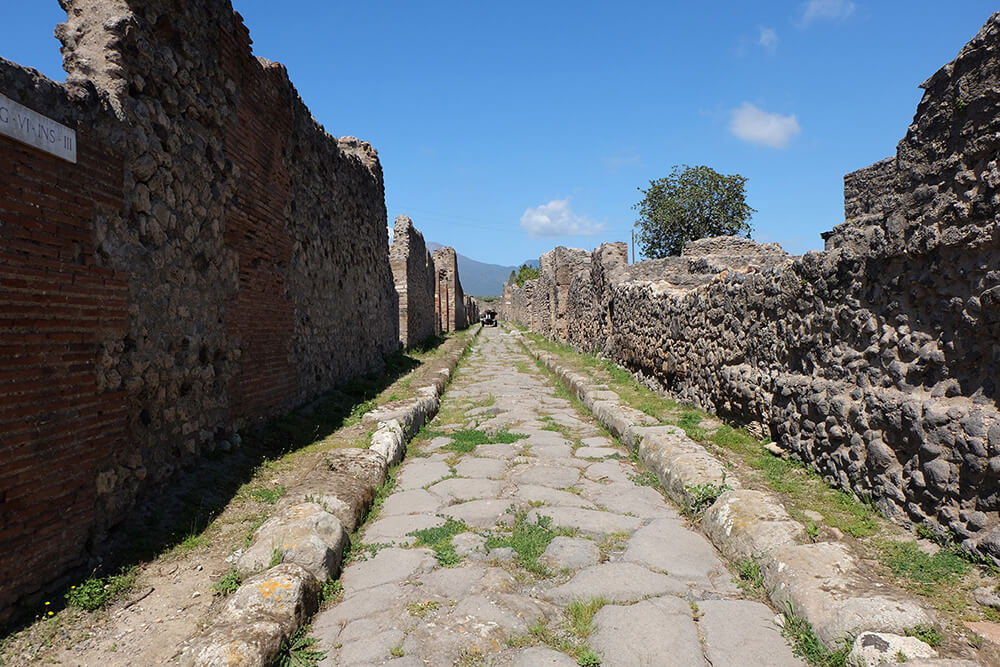
In Herculaneum, the town was buried almost instantly in hot ash. The buildings in Herculaneum are much better preserved than those in Pompeii; many of them have their upper floors still intact, and a couple even have their original wooden balcony. Unbelievably, some of the shops still have fittings.
Herculaneum was also a wealthier town than Pompeii, so many of the buildings you’ll see are more opulent and richly decorated. The mosaics and frescos are brighter, larger and more intricate here, a real treat for the eyes.
While you definitely can imagine yourself living in Pompeii as you walk its Roman streets, in Herculaneum the effect is really powerful. If you close your eyes, you can almost hear and sense the Roman life going on around you – it’s truly like a living museum.
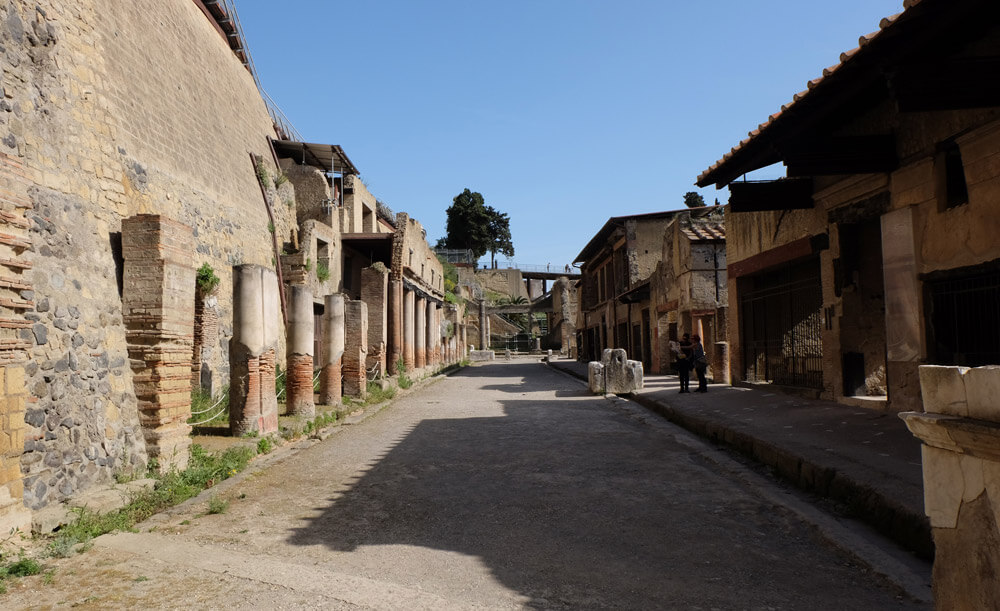
The fact that Herculaneum is better-preserved means that it’s much easier to make sense of how it worked as a town. In Pompeii it’s essential to take a guided tour to understand what you’re looking at; signs are few and far between and the grid layout makes it easy to get lost.
The excavated part of Herculaneum is far smaller than Pompeii, and each street has its own landmarks. The information signs and directions at Herculaneum are much better as well, and if you’ve taken a guided tour of Pompeii, there’ll be plenty that you’ll recognise from the other site.
Herculaneum is much smaller and quieter than Pompeii
Herculaneum gets around 300,000 visits a year compared to Pompeii’s 3.5 million, and while it is a much smaller site, the lower number of visitors gives it quite a tranquil feel. You won’t experience crowds at Herculaneum, or queues to see the most famous sights.
The sheer volume of hot ash which rained down on Herculaneum means that the modern town of Ercolano is at a much higher level than the ancient one, and as you walk down the long ramp into the ruins you’re surrounded by wild flowers and birdsong. It’s like stepping into another world.
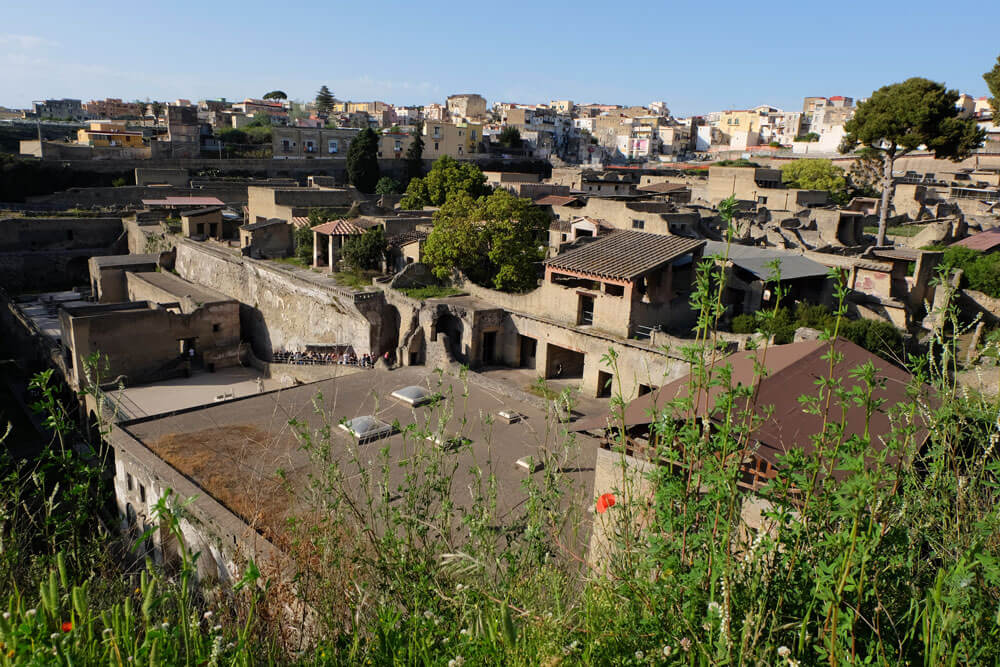
That tranquil feel, and the sense that the inhabitants have only just left, makes their deaths even more horrific. After you’ve seen the buildings where they lived, worked and socialised, you’ll reach the place where many of them died.
As you round the corner to the ancient beach (the eruption pushed the seafront 500m further out to sea) you’ll see the boathouses, and inside them, hundreds of skeletons. As these people sheltered in hope of being rescued by boat, an intense wave of hot gas hit the town. Until just a few years ago it was thought that they’d died instantly, their flesh vaporised. Unfortunately, more recent research suggests that they choked to death on the poisonous fumes as rising temperatures cooked their bodies.
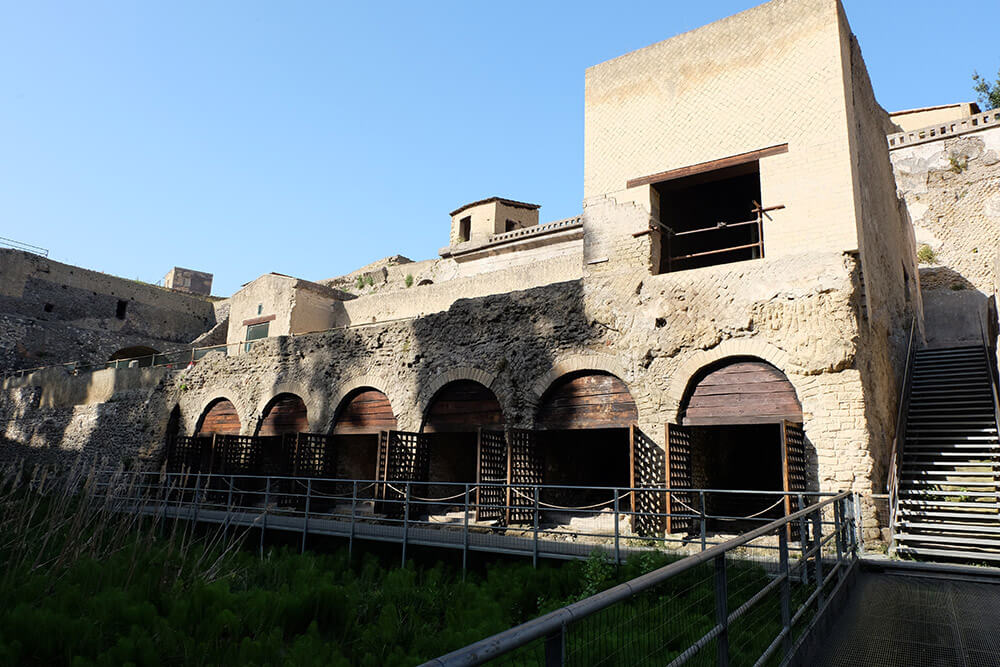
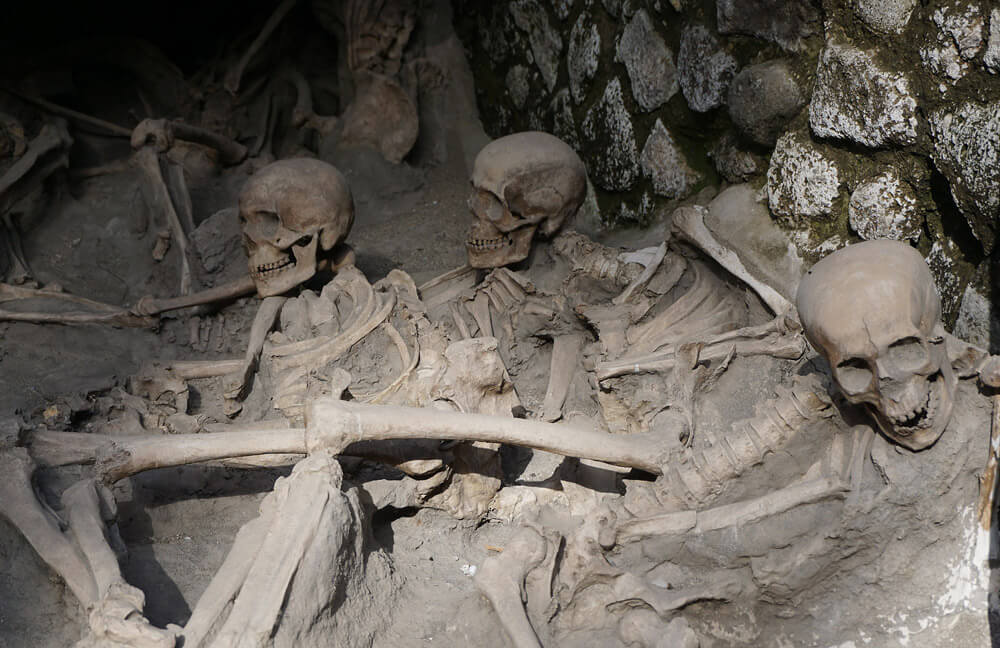
Which is better, Herculaneum or Pompeii?
It’s really difficult to choose between Herculaneum and Pompeii. If you’re interested in Roman history and what happened when Mount Vesuvius erupted, it’d be a real shame not to visit its most famous sight, Pompeii. Having said that, many people do prefer Herculaneum to Pompeii for its lack of crowds, stunning preservation and being able to see more sights in a shorter space of time with less walking.
If you’re determined to visit Pompeii, visiting Herculaneum as well adds a lot of extra richness to your trip, and it’s definitely worth visiting. It’ll give you a better understanding of what the buildings you saw in Pompeii would have looked like when they were complete, and a better feel for what the inhabitants’ lives were like.
The extra level of preservation at Herculaneum is absolutely amazing, and because it’s so close to Pompeii and so much smaller, it’s not too much extra effort to visit both. I do recommend visiting Pompeii before Herculaneum and taking a guided tour as it’ll help you understand both sites better.
Read more: Pompeii or Herculaneum – which site should I visit?
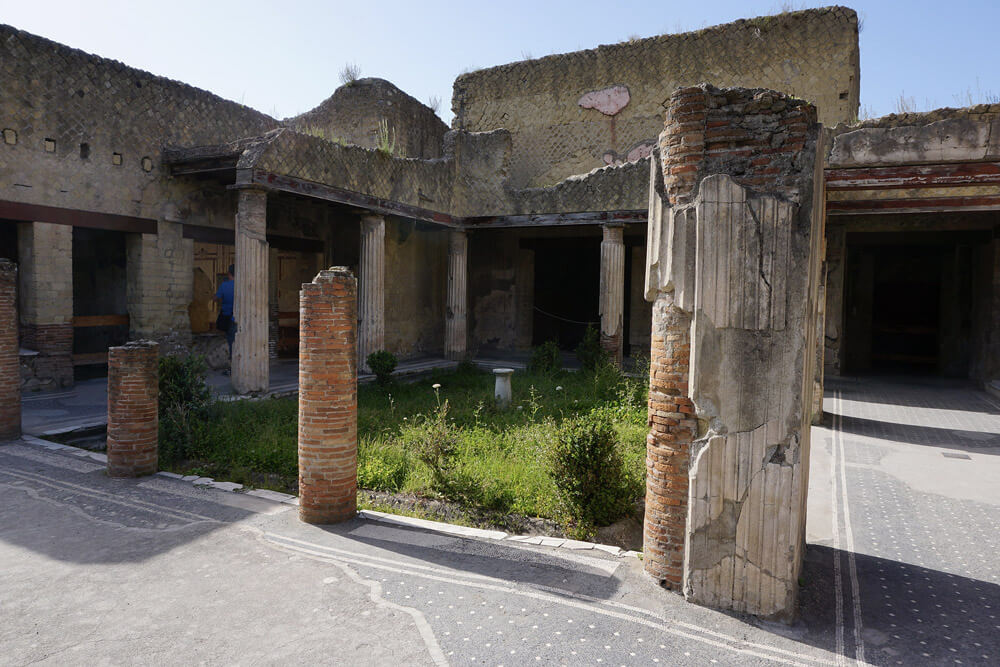
Top-rated Pompeii and Herculaneum tours
Pompeii entry ticket and guided tour with an archaeologist
Herculaneum: Skip-the-Line Guided Tour with Archaeologist
From Rome: Pompeii and Herculaneum Tour with High-speed Train
Can you see Pompeii and Herculaneum in one day?
It’s possible, but trying to visit both Pompeii and Herculaneum in one day would be exhausting. Pompeii is an enormous archaeological site, and visiting it is a lot like visiting a modern city, with the key sights spread out across the whole area. It’s definitely not a good idea to try and visit Herculaneum and Pompeii as a day trip from Rome – with the travel it’s just too much.
I also found visiting the two Roman cities where so many people died quite emotional; the casts of the bodies at Pompeii are really tragic, while the skeletons at Herculaneum are actually rather horrifying. I think visiting Herculaneum and Pompeii on the same day might be quite emotionally, as well as physically tiring.
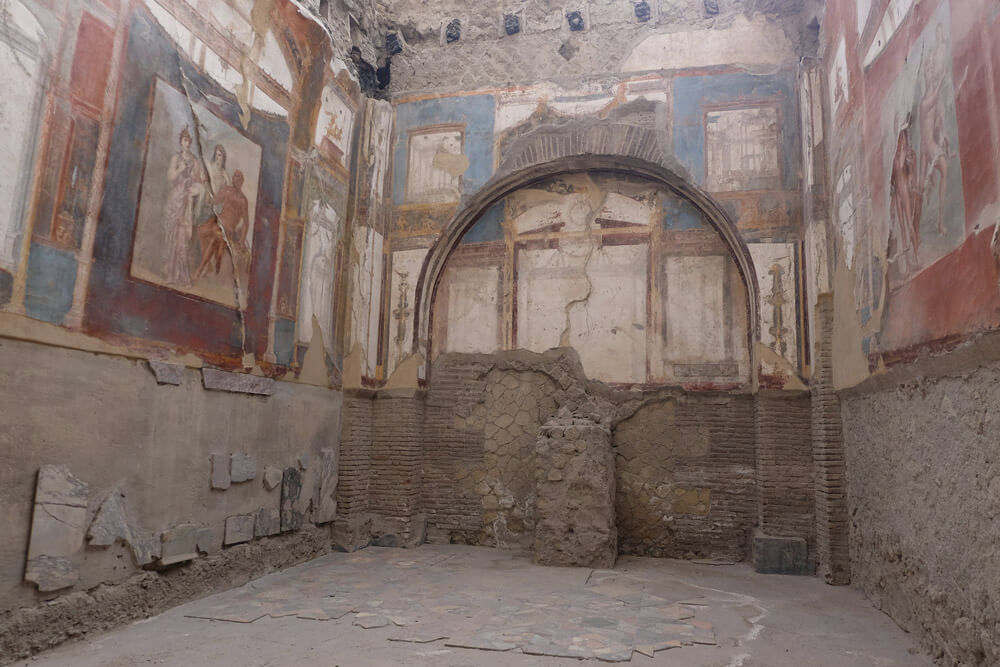
My recommended option for visiting Pompeii and Herculaneum is to first spend one full day at Pompeii, taking one of the official guided tours, then spend another day visiting Herculaneum and the crater at the top of Vesuvius. I spent around 3 hours at Herculaneum, leaving plenty of time to climb Vesuvius.
Getting to Mount Vesuvius from Herculaneum
Climbing Vesuvius is really easy from Ercolano (modern Herculaneum). Vesuvio Express buses leave from outside Ercolano train station (the same station that you’ll use to get the Circumvesuviana train to and from Naples and Sorrento) and take you up to the car park nearest the crater.
The buses depart at regular intervals, and give you around 90 minutes at the volcano – enough time to walk up to the crater, take a look around, and walk down again. A round trip transfer ticket is 12 euro per person, or 30 euro including a ticket for the hike up to the crater.
Read my tips for climbing Vesuvius
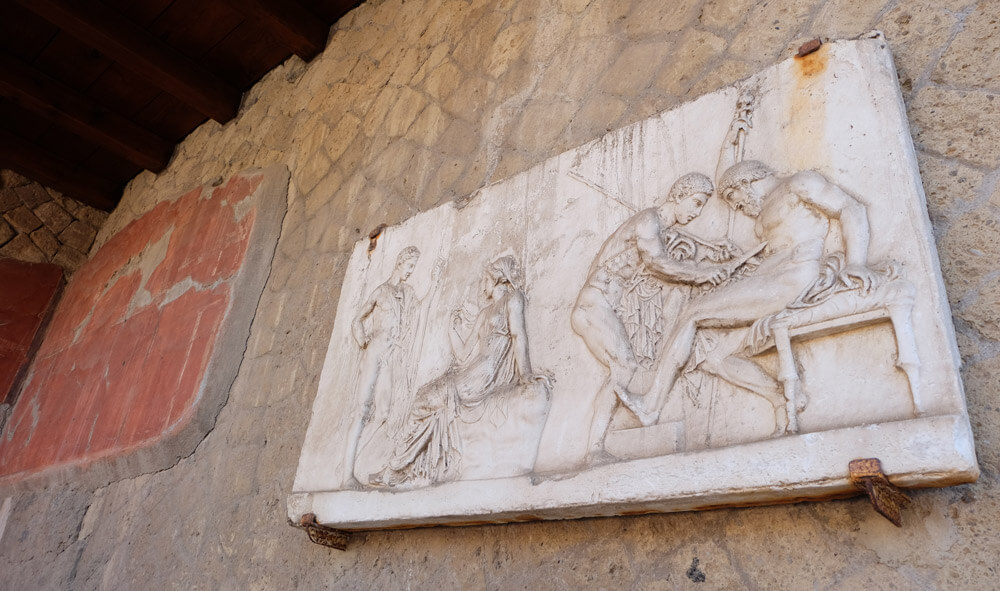
More things to do in Herculaneum (Ercolano)
Away from the main excavated site at Herculaneum, there are a couple of other interesting things to see when you go to Ercolano.
The MAV Virtual Archaeology Museum uses technology to bring the Roman cities of Pompeii and Herculaneum back to life. Through a series of interactive exhibits you can experience Roman life as it was just before the eruption. It’s an interesting way to get a different perspective on the ruins. It’s open 10am to 4pm, Tuesday to Sunday.
The Theatre of Herculaneum was the first trace of ancient Herculaneum to be rediscovered. In 1710, a man named Ambrogio Nocerino was digging a well and came across a 2,500-seat Roman theatre by accident. His find led to work starting on the excavations that we see today, but the theatre he found is still 20 metres underground, covered by the volcanic ash and accessible only by tunnels. It’s one of the best-preserved Roman theatres anywhere in the world.
Unfortunately, steep, dark tunnels and fragile historic buildings aren’t a great combination for a tourist attraction so it hasn’t generally been open to the public. However, the Theatre of Herculaneum did open in summer 2022 for an experimental series of guided tours. These didn’t happen in 2023 but the Ercolano website suggests that some dates will be announced for summer 2024.
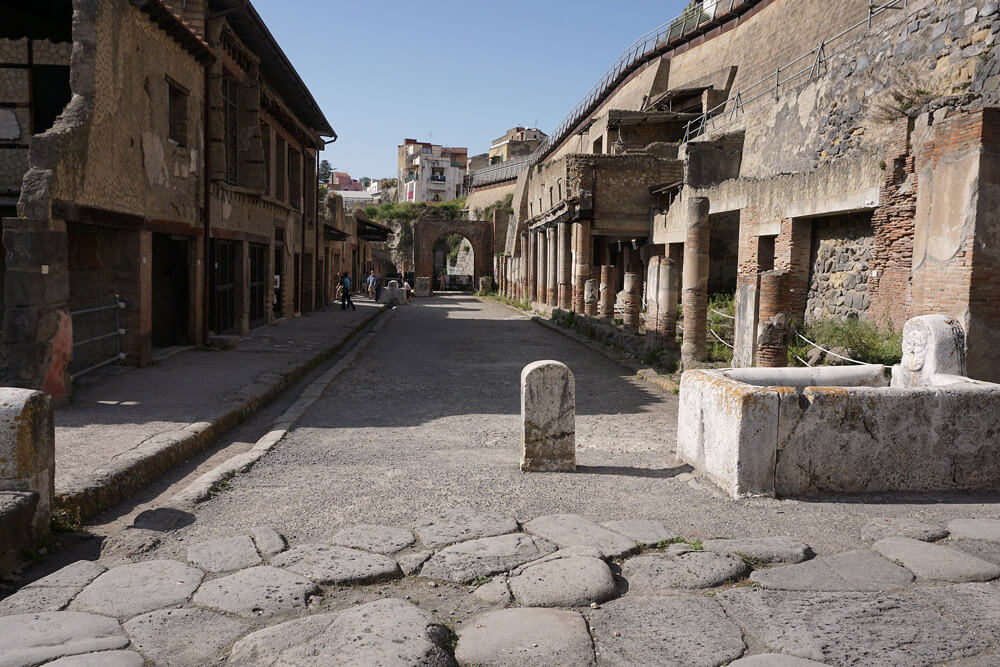
Practical advice for visiting Herculaneum in 2024 and 2025
How to buy tickets for the Herculaneum ruins
Herculaneum is quieter than Pompeii and there’s usually no need to book tickets in advance. If you want to take a guided tour, I’d recommend booking that in advance as I didn’t see anyone offering tours on the spot like I did at Pompeii.
If you’re planning to go to Pompeii and Vesuvius as well as visiting Herculaneum, you can buy the Campania Artecard which will get you into both sites (plus a number of other sightseeing spots in the area) over the course of your visit.
There are five different versions of the Campania Artecard and it can get confusing comparing what’s included in each one, so I’ve put together a complete Campania Artecard review. I personally think that the Artecard Lite 365 is an absolute bargain if you’re spending a few days in the area.
Herculaneum opening hours
Winter opening hours are from 15 October 2024 to 15 March 2025. For the winter period, the ruins at Herculaneum are open from 8.30am to 5pm, with the last admission at 3.30pm. Visitors must leave the archaeological area by 4.40pm.
Summer hours for Herculaneum in 2025 are from 16 March to 14 October. In summer, the site is open from 8.30am to 7.30pm. The last admission is at 6pm, and visitors must leave the site by 7pm.
Herculaneum is also closed on January 1st (New Year’s Day) and December 25th (Christmas Day). It’s free to visit Herculaneum on the first Sunday of the month, plus 25 April, 2 June and 4 November.
Please check these timings before your visit on the Herculaneum official website.
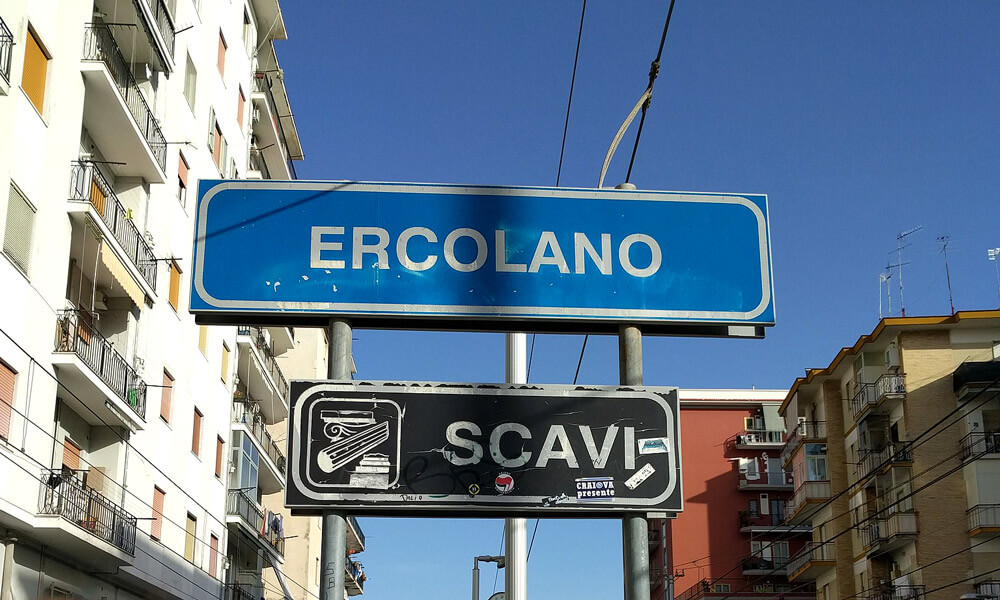
How to get to Herculaneum from Naples
The easiest way to visit Herculaneum from Naples is by taking the Circumvesuviana train from Napoli Centrale (Piazza Garibaldi) to Ercolano. The trains are a bit scruffy and get very crowded but run regularly. The Naples to Herculaneum train will take around 25 minutes.
To maximise your chances of getting a seat, try getting on at Porta Nolana station, one stop before Napoli Centrale. Get off at Ercolano Scavi station and walk straight down the hill towards the ruins. The walk from the station to the Herculaneum ticket office takes around 10 minutes.
Visiting Herculaneum from Sorrento
The journey from Sorrento to Herculaneum is another really easy trip on the Circumvesuviana train. Get on the train at the station in the centre of Sorrento and get off at Ercolano Scavi. The train from Sorrento to Ercolano takes around 40 minutes; at peak times there’s a train every 15 minutes.
When you get off the train, walk down Via IV Novembre towards the sea – the route to the Herculaneum ruins is reasonably well-signposted so you can’t go wrong. There are a number of shops, cafes and restaurants on this street as well so it’s easy to stop for a drink or something to eat either before or after your visit.
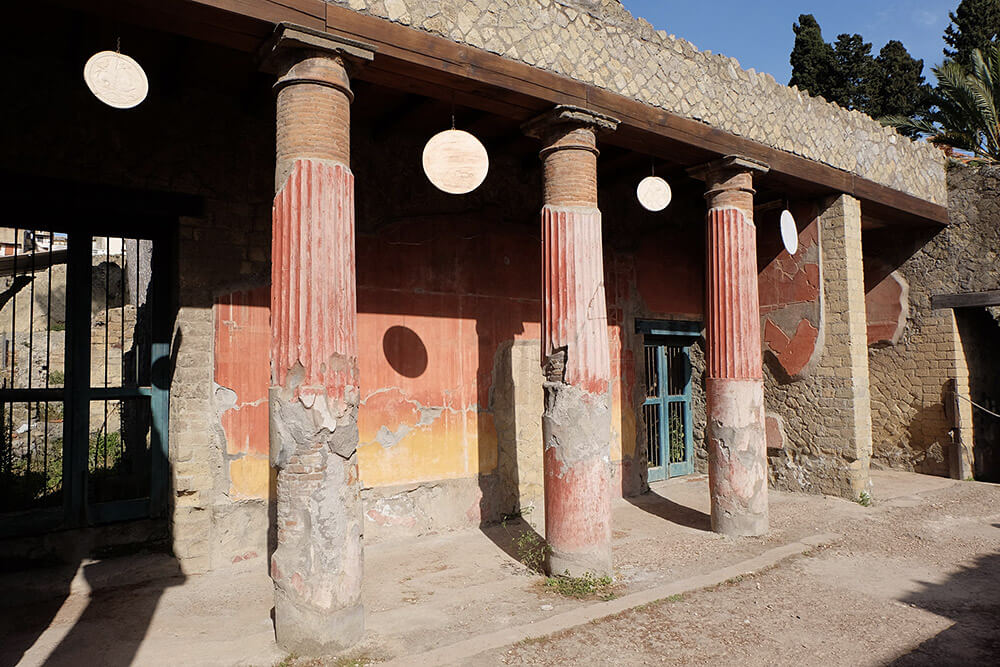
Can I take a guided tour of Herculaneum?
Guided tours are available at Herculaneum, but if you’ve done a tour at Pompeii and perhaps done some reading before your visit, I don’t think it’s essential – remember to pick up a paper map at the entrance though. Part of the reason for taking a guided tour at Pompeii is simply because of the scale of the site – there’s a really good chance that you’d get lost there without a guide!
At Herculaneum, the site is far smaller and the signage and explanations are also much better than at Pompeii. If you want a tour but you haven’t booked in advance, you can download the Ercolano app on Android phones, or you can hire an audio guide from the ticket office at the entrance.
Facilities at the Herculaneum archaeological site
The ticket office at the entrance to Herculaneum includes a small museum, toilets, luggage storage and a bookshop. There’s also a vending machine for food and drink near the entrance. There’s no restaurant or cafe on site but there are plenty of cafes nearby.
If you’re driving to Herculaneum there’s no official parking for the site but there are public car parks nearby.
Large bags (bigger than 35 x 30 x 15 cm) need to be left at the entrance but luggage storage is free.
Where to stay when you visit Herculaneum
The best places to stay when you visit Herculaneum and Pompeii are Naples or Sorrento. Modern Ercolano and Pompei might be geographically closer, but they’re both working towns, and apart from the ruins there’s not much else to do for visitors.
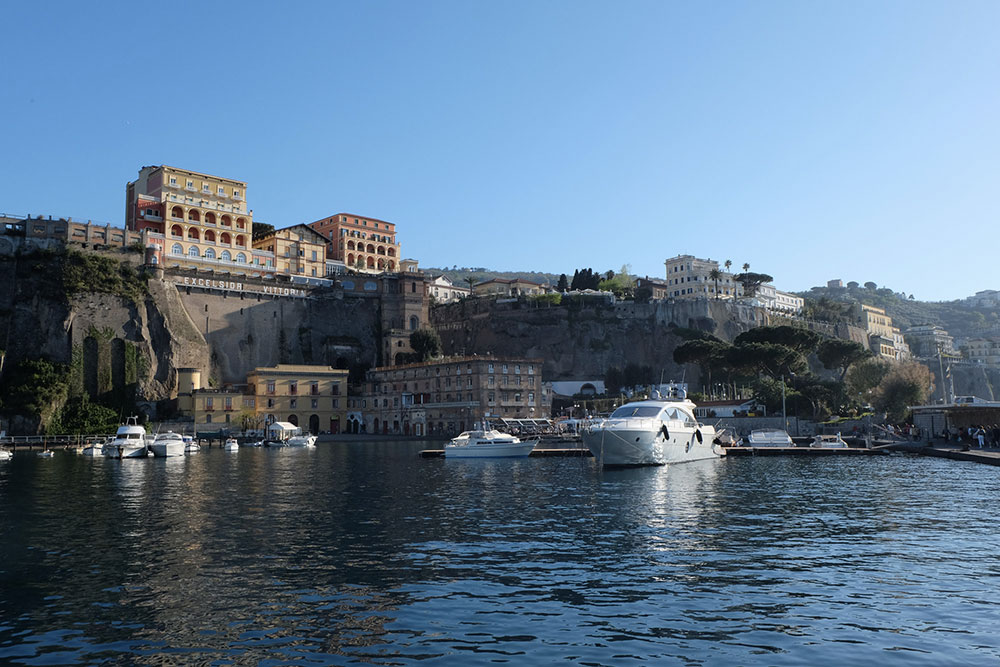
If you’re touring Italy and are short on time, stay in Naples. Naples has super-fast train services to Rome and other cities in Italy, and it also has an international airport. Naples definitely has a gritty reputation, but for convenience to get to and from Herculaneum and Pompeii, it can’t be beaten.
If you’re looking to build a relaxing vacation around your trip to Pompeii and Herculaneum, I’d recommend staying in Sorrento. Sorrento is at the end of the Circumvesuviana train line from Naples, which also stops at Pompeii and Herculaneum, making getting to both Roman sites really easy.
Read more about where to stay to visit Pompeii and Herculaneum
There are loads of things to do in Sorrento; it’s a gorgeous town in its own right, and it’s particularly well-placed for day trips to Capri, Ischia, Procida and the Amalfi coast. Sorrento is also very welcoming for tourists, with a wide range of hotels, restaurants and bars, making it an easy, as well as scenic, option after long days spent exploring the Roman cities.
Related posts
If you enjoyed this post, you might find my other posts about places to visit near Naples useful:
- 12 tips for visiting the ancient Roman city Pompeii (plus how to climb Vesuvius)
- The best day trips from Sorrento
- The best places to stay to visit Pompeii
- The best things to do in Ischia
- How to get from Naples to Ischia by ferry
- Where to stay in Ischia – the best villages, beaches and hotels for every type of trip
- Visiting Ischia’s best thermal spa, Negombo
- How to visit Giardini la Mortella, a garden love story on Ischia
- Tips for visiting Castello Aragonese in Ischia Ponte
- Guide to visiting Procida, the tiny, beautiful island that’s a perfect day trip from Naples
- Amazing Roman ruins to visit
Would you visit Herculaneum?
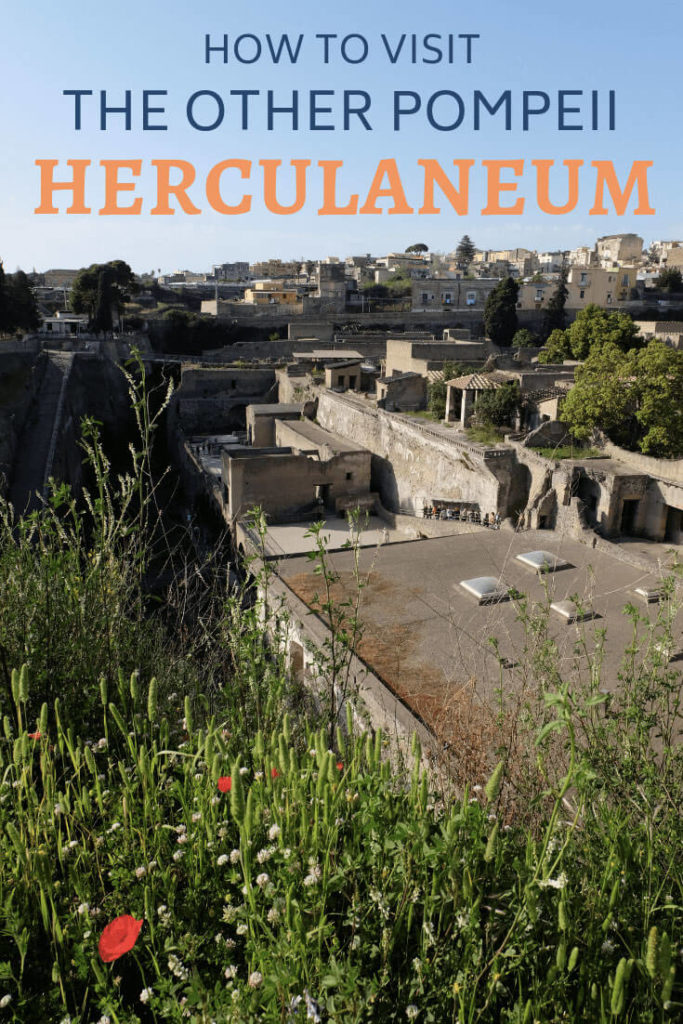
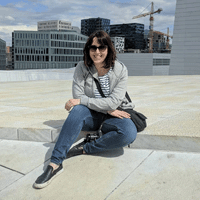
About Helen
Hi! I’m Helen, and Italy is one of my favourite destinations. I’ve been fascinated by ancient Roman and Greek history since I was a kid and I love nothing more than combining a visit to a Roman site with experiencing Italy’s beautiful landscapes and cities.
I live near Manchester, UK and work full time, so I’m all about making the most of my annual leave with day trips, weekend getaways and short breaks.

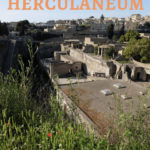
Hi, I enjoyed visiting your site, very helpful, Can I ask you if you know if there is a ticket machine at Ercolano Scavi train station, Thanks
Hi Robert, glad you found it useful! I’m not sure as we bought return tickets from Sorrento to Ercolano, but I would think there would be a way to buy tickets.
thank so much for the informative post,
I am planning a trip to Italy and never even knew about Herculaneum until I scrolled through your post about Pompeii and saw the following post
Wow definitely on my list as I am over age 75 and know that I will be able to manage the smaller site
Thank you Heather, so glad it was helpful! If you do visit Pompeii then I’d recommend using the Porta Marina entrance as there’s a higher concentration of sights (the Forum, the arch of Nero, some temples and the Antiquarium museum) around that entrance compared to Piazza Anfiteatro which is closer to the large villas and the plaster casts at the Garden of the Fugitives.
You might also want to look at the Pompeii for all route – it’s still 3.5km but it’s designed for wheelchairs so less tiring than walking on the uneven roads. I hope you have a wonderful trip to Italy!
This is actually really pretty, I didn’t know about this site. I’ve been looking for travel destinations for my wife’s birthday, and this looks like something she would enjoy much!
We’ve been talking about Italy too, we’ll dedicate a day of our trip to visiting this ancient city. thank you!
Thanks David, hope you have a great trip!
Fascinating. We debated for a while when we were there as to which site to visit. We opted for Pompeii, and it was so crowded. After reading this, I am pretty sure for us, we made the wrong choice. If we ever get back, Herculaneum will be the top of our list
I don’t think there’s really a wrong choice as Pompeii is amazing, but I do really recommend a visit to Herculaneum 🙂
We went here a number of years ago instead of Pompeii. Very intense day. I think I’d like to go back and see Pompeii too. Herculaneum was quiet and hardly any crowds.
It’s amazing how quiet Herculaneum is isn’t it. I hope you get to see Pompeii too.
I just missed Herculaneum, arriving seconds after the ticket office shut and I was so cross with myself! I definitely want to get there soon. Your guide is super useful.
Oh no what a shame! I hope you manage to get back there and visit Herculaneum.
I love to explore historic sites and this place looks stunning. Thanks for the historic facts of how herculeam is differed from pompei. Will certainly visit this when I m in italy
Thanks Sinjana, if you’re into history then you’ll find both Herculaneum and Pompeii fascinating.
Thank you for this! I’m going to Naples later this year and am now thinking of adding Herculaneum to our itinerary!
I definitely recommend a visit to Herculaneum, it’s amazing to think of what else might be hidden underneath the modern town.
Couldn’t agree more that people should visit The Other Pompeii. Honestly, I never get tired of either one but agree that Herculaneum is a bit better preserved. Great post!
I do think people should go to both but then I love both so I would, haha. I think there’s lots of people for whom Herculaneum is a better option – Pompeii is amazing but it isn’t an easy place to visit if you’re not up for a ton of walking on those uneven roads and you’re not prepared to put a bit of work in to understand it. Herculaneum is a lot more accessible in every sense.
We plan to go back to Italy this year (Rome is my most favorite city in the world!), and I’ve always skipped Pompeii because of crowds. Thank you for this in-depth article about another, quieter option, as well as the suggestion to stay in Sorrento!
I visited Pompeii in April and honestly it wasn’t too bad. We got there mid morning and the key sights were busy but nothing that made our visit unpleasant. The site’s so big that if you step away from the main streets you can be on your own. However Herculaneum is significantly quieter and so interesting. I definitely recommend a visit!